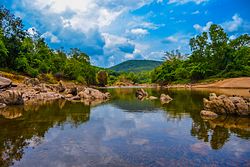| Chandragiri River Perumpuzha / Payaswini | |
|---|---|
 A view of the Chandragiri river from Kanathur, Kasaragod | |
 | |
| Etymology | Chandragupta Maurya[1] |
| Location | |
| Country | India |
| State | Kerala, Karnataka |
| District | Kasaragod, Dakshina Kannada, Kodagu |
| Cities | Sullia, Jalsoor, Chengala, Chemnad, Kasaragod |
| Physical characteristics | |
| Source | Kadamakal Reserve Forest, Karnataka |
| • location | Kodagu District, India |
| • coordinates | 12.45495°N, 75.67224°E |
| • elevation | 1290m |
| Mouth | Arabian Sea |
• location | Near Thalangara, Kasaragod, India |
• coordinates | 12°28′25″N 74°59′04″E / 12.4737°N 74.9845°E |
• elevation | 0 m (0 ft) |
| Length | 105 km (65 mi) |
| Discharge | |
| • location | mouth |
| Basin features | |
| Tributaries | |
| • left | Kudumbur River |
The Chandragiri River, also known as the Payaswini River in Karnataka and as the Perumpuzha River in Kerala,[2][3][4] is the longest river in Kasaragod district, Kerala, India. The river is a historical treasure of Chemnad. It was named after the Mauryan emperor Chandragupta Maurya.[5][6][7]
The river originates in the Talakaveri Wildlife Sanctuary in the Western Ghats of Kodagu district, Karnataka. It flows through towns including Sullia, Jalsoor, Parappa, Adoor, Chengala, Kasaragod and Chemnad and then later flows into the Arabian Sea. In Sullia taluk, it is the major water source for domestic and agricultural purposes. Chemnad is considered as the Land Of Chandragiri.[citation needed]
- ^ "Kasaragod Rivers". www.keralatourism.org. Retrieved 23 January 2021.
- ^ S. Jayashanker (2001). Temples of Kasaragod District. Controller of Publications. p. 4.
- ^ Adoor K. K. Ramachandran Nair (1986). Kerala State Gazetteer. State Editor, Kerala Gazetteers. p. 9.
- ^ "Namboothiri Rulers (Naaduvaazhikal)". www.namboothiri.com. Retrieved 12 July 2021.
- ^ "District Census Handbook - Kodagu District 2011" (PDF). Directorate of Census Operations-Karnataka. 1 October 2011. Retrieved 22 January 2021.
- ^ "District Census Handbook - Dakshina Kannada District 2011" (PDF). Directorate of Census Operations-Karnataka. 1 October 2011. Retrieved 22 January 2021.
- ^ "District Census Handbook - Kasaragod District 2011" (PDF). Directorate of Census Operations-Kerala. 1 October 2011. Retrieved 22 January 2021.